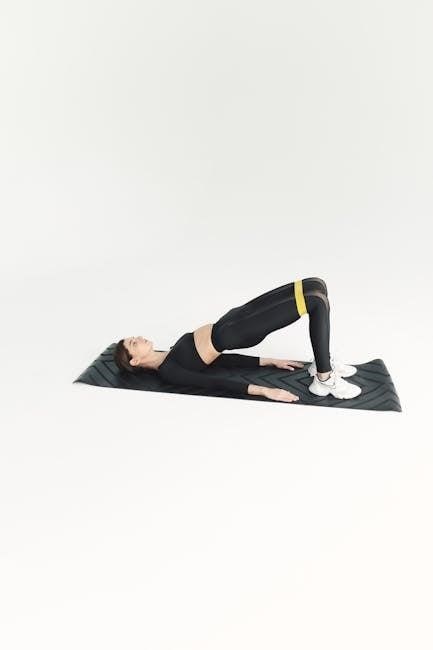Overview of Iliotibial Band Syndrome (ITBS)
Iliotibial Band Syndrome (ITBS) is an overuse injury causing pain on the lateral side of the knee, commonly affecting runners. It involves inflammation of the IT band, a fibrous tendon running from the hip to the knee.
1.1 Definition and Common Causes
Iliotibial Band Syndrome (ITBS) is inflammation of the iliotibial band, a fibrous tendon running from the hip to the knee. It causes lateral knee pain, often due to repetitive friction during activities like running or cycling. Common causes include overuse, tight hip muscles, and weak glutes. Poor training habits, such as sudden increases in mileage, and biomechanical issues like leg length discrepancies also contribute. ITBS is not caused by a single injury but rather by prolonged stress on the IT band, leading to irritation and inflammation over time.
1.2 Prevalence in Runners and Athletes
Iliotibial Band Syndrome (ITBS) is highly prevalent among runners and cyclists, with studies suggesting it affects up to 12% of runners annually. The repetitive nature of these sports, involving frequent knee flexion and extension, increases the risk of irritation to the IT band. Athletes who suddenly increase their training mileage or intensity are particularly vulnerable. Additionally, activities like hiking and repetitive pivoting movements in team sports can also contribute to ITBS. The syndrome is often cited as one of the most common overuse injuries in endurance athletes, making it a significant concern for those engaging in high-mileage or repetitive leg-based activities.

Symptoms of ITBS
ITBS typically causes sharp, stabbing pain on the lateral side of the knee, worsened by activities like running or cycling. Pain often occurs during knee flexion.
2.1 Pain on the Lateral Side of the Knee
The primary symptom of ITBS is sharp, stabbing pain on the outer side of the knee. This discomfort often intensifies during activities like running or cycling. The pain is usually localized where the IT band crosses the lateral femoral condyle, typically at 30 degrees of knee flexion. It may radiate along the lateral thigh but rarely extends below the knee. Pain can also occur suddenly, especially when transitioning from rest to activity. Consistent discomfort during repetitive knee movements is a hallmark of ITBS, making it a common complaint among athletes and runners.
2.2 Tenderness Along the IT Band
Tenderness along the IT band is a hallmark symptom of ITBS, often felt as a sharp or dull ache on the outer thigh. This discomfort typically worsens with activities like running or cycling. The IT band runs from the hip to the knee, and tenderness is most pronounced where it crosses the lateral femoral condyle. Palpation (pressing on the area) can elicit pain, especially at 30 degrees of knee flexion. The tenderness may extend along the band’s length but is most concentrated near the knee. This symptom is a key diagnostic indicator, helping differentiate ITBS from other knee injuries.

Diagnosis of ITBS
Diagnosis involves physical examination, palpation, and patient history. Tenderness along the IT band and pain during specific movements confirm the condition, often supported by imaging to rule out other injuries.
3.1 Physical Examination and Tenderness Locations
A physical exam for ITBS focuses on identifying tenderness along the IT band, particularly near the lateral femoral condyle. Pain is typically felt when pressure is applied to this area or during knee flexion. The healthcare provider may also assess the knee’s range of motion and strength. Palpation along the IT band, from the hip to the knee, can reveal localized tenderness. Specific movements that reproduce pain, such as squatting or stairs, further support the diagnosis.
3.2 Differentiating ITBS from Other Knee Injuries
ITBS must be distinguished from other knee injuries like meniscal tears or ligament sprains. Unlike these conditions, ITBS typically presents with lateral knee pain worsened by repetitive activities. Swelling is minimal, and instability is absent. Tenderness is localized along the IT band, particularly near the lateral femoral condyle. Specific tests, such as Ober’s test, can help identify IT band tightness. Imaging may rule out structural damage, confirming the diagnosis of ITBS over other pathologies. Accurate differentiation is crucial for appropriate treatment and rehabilitation.
Stretching Exercises for ITBS
Stretching exercises target the IT band and surrounding muscles to improve flexibility and reduce pain. Standing, side-lying, and seated stretches are effective for ITBS management.
4.1 Standing Iliotibial Band Stretch
To perform the standing IT band stretch, stand near a wall for support. Cross your affected leg behind your unaffected leg, bending the front knee slightly. Lean toward the unaffected side until a stretch is felt on the lateral side of the thigh. Hold for 30-60 seconds, then switch sides. This stretch targets the IT band and improves flexibility. Repeat 2-3 times daily for optimal results. It’s essential to maintain proper posture and avoid bouncing to avoid injury. Regular practice helps alleviate ITBS symptoms and enhances range of motion;
4.2 Side-Lying IT Band Stretch
Lie on your side with the unaffected leg on the bottom and the affected leg on top. Bend both knees to 90 degrees, keeping the feet aligned. Slowly let the top hip drop toward the floor until a stretch is felt along the lateral thigh. Hold for 30 seconds, then return to the starting position. Repeat 2-3 times on each side. This stretch targets the IT band and surrounding tissues, improving flexibility and reducing tightness. Perform gently to avoid discomfort and enhance recovery from ITBS symptoms.
4.3 Seated IT Band Stretch
Sit on the floor with your legs extended straight. Cross the affected leg over the unaffected leg, placing the ankle on the opposite knee. Gently lean forward from your hips until a stretch is felt along the lateral thigh. Hold for 30 seconds, then slowly release. Repeat 3 sets daily. This stretch targets the IT band and hip muscles, improving flexibility and reducing tightness. Perform gently to avoid discomfort and enhance recovery from ITBS symptoms. Consistency is key for long-term relief and prevention of future episodes. A wall can be used for support if needed.
4.4 Dynamic IT Band Stretch
Stand with your feet hip-width apart. Cross your right leg behind your left, bending both knees slightly. Slowly swing your right leg forward, then backward, repeating the motion for 30 seconds. Switch sides. This dynamic stretch improves IT band flexibility and reduces tightness through active movement. Perform 3 sets daily to enhance recovery and prevent ITBS symptoms. Focus on controlled, smooth movements to maximize effectiveness without causing discomfort. Dynamic stretching is particularly beneficial for runners and athletes, as it mimics natural leg movement and promotes optimal muscle function during activity. Consistency is key for long-term relief and injury prevention.

Foam Rolling Techniques
Foam rolling the IT band involves rolling from the hip to the knee using a foam roller. Apply moderate pressure, focusing on tender areas to relieve tension. Perform 2-3 times daily for 5-10 minutes to improve flexibility and reduce inflammation. This technique is essential for recovery and prevention of ITBS symptoms. Consistency enhances outcomes, making it a key component of rehabilitation routines. Regular foam rolling helps maintain IT band health in runners and athletes. Always roll slowly and avoid bouncing to maximize effectiveness. This method complements stretching exercises for optimal recovery. Use a high-quality foam roller for best results.
5.1 Foam Rolling the IT Band
Foam rolling the IT band involves using a foam roller to apply pressure and release tension along the lateral thigh. Position your body on the roller, focusing on the area from the hip to the knee. Roll slowly, applying moderate pressure, and pause on tender spots to release muscle tightness. Use your body weight to control the pressure, avoiding bounces or rapid movements. Regular foam rolling helps reduce inflammation, improve circulation, and relieve pain associated with ITBS. It is recommended to roll 2-3 times daily for 5-10 minutes per session. Consistency is key for effective relief and prevention.
5.2 Frequency and Duration of Foam Rolling
Foam rolling the IT band should be performed 2–3 times daily, with each session lasting 5–10 minutes. Start with 3 sets of 60 seconds per session, gradually increasing as comfort allows. Focus on areas of tenderness, applying moderate pressure and rolling slowly. Consistency is key to reducing inflammation and improving circulation. Adjust frequency based on discomfort levels, ensuring not to over-roll, which can cause further irritation. For best results, incorporate foam rolling into your daily routine, especially before and after physical activity. If pain persists, consult a professional to refine your technique and ensure effectiveness.
Strengthening Exercises for Rehabilitation
Strengthening exercises target the hip abductors and glutes to improve joint stability and reduce IT band tension, enhancing overall lower limb function and promoting recovery from ITBS.
6.1 Clamshell Exercise
The clamshell exercise strengthens the gluteus medius and minimus, crucial for hip stability. Lie on your side with knees bent and feet touching. Slowly lift the top knee without moving the feet, holding for 3-5 seconds. Perform 3 sets of 15-20 repetitions. This exercise improves hip abductor strength, reducing IT band tension and alleviating symptoms of ITBS. Proper form is essential to target the correct muscles and avoid strain.
6.2 Glute Bridges
Glute bridges are an effective exercise for strengthening the glutes and hamstrings, which helps stabilize the hip and knee. Lie on your back with knees bent and feet flat. Slowly lift your hips toward the ceiling, squeezing your glutes at the top, and hold for 3-5 seconds. Lower your hips back down and repeat for 3 sets of 15-20 repetitions. This exercise improves hip extension and reduces IT band tension, aiding in ITBS recovery. Focus on controlled movements and avoid arching your back to prevent strain.
6.3 Step-Ups
Step-Ups are a strengthening exercise targeting the hip abductors and quadriceps, essential for hip and knee stability. Stand in front of a sturdy platform or bench with your right foot resting on the step. Step up with your left foot, ensuring your trailing leg does not push off the ground. Slowly lower yourself back down and repeat on the other side. Perform 3 sets of 10-15 repetitions per leg. Focus on proper form to avoid knee strain. This exercise strengthens the glutes and improves hip stability, reducing IT band tension and aiding in ITBS recovery. Avoid rushing the movement for optimal results.

Prevention Strategies
Prevent ITBS through proper warm-ups, consistent stretching, and activity modification. Incorporate core and leg strengthening exercises to enhance stability. Avoid overexertion and use trekking poles if necessary.
7.1 Proper Warm-Up and Stretching
A proper warm-up and stretching routine are crucial for preventing ITBS. Begin with dynamic stretches like leg swings and lunges to increase blood flow to the muscles. Focus on stretching the IT band, hamstrings, and hip flexors. Incorporate exercises such as standing IT band stretches and side-lying stretches to improve flexibility. Hold each stretch for 20-30 seconds and repeat 2-3 times. Consistency is key; perform these stretches before and after physical activity to reduce tightness and inflammation in the IT band.
7.2 Activity Modification
Activity modification is essential to prevent ITBS aggravation. Reduce mileage or intensity in high-impact sports like running or cycling. Avoid repetitive movements that stress the IT band. Substitute high-impact activities with low-impact alternatives, such as swimming or yoga, to minimize irritation. Incorporate cross-training to diversify your workout routine and reduce overuse. If symptoms persist, consider temporary rest or altering your training surface to softer terrains. Gradually resume activities to avoid re-injury, ensuring proper recovery between sessions. These adjustments help alleviate strain on the IT band, promoting long-term recovery and preventing recurrence.

Recovery and Rest
Recovery involves the RICE method, proper rest, and avoiding aggravating activities. Allow the IT band time to heal to prevent further irritation and promote effective rehabilitation.
8.1 RICE Method (Rest, Ice, Compression, Elevation)
The RICE method is a standard approach for managing ITBS. Rest helps avoid further irritation, while ice reduces pain and inflammation. Apply ice for 15-20 minutes, 2-3 times daily. Compression with an elastic bandage provides support, and elevation reduces swelling. This method is most effective in the acute phase of injury. Consistency is key to promote healing and prevent worsening symptoms. It is often recommended to avoid activities that aggravate the condition during this period. Gradual return to activity should only occur when pain subsides and mobility improves.
8.2 Gradual Return to Activity
A gradual return to activity is crucial after ITBS symptoms subside. Start with low-impact exercises like cycling or swimming to minimize stress on the knee. Introduce running or high-impact activities slowly, monitoring for pain. Incorporate strength and flexibility exercises to support recovery. Avoid sudden increases in intensity or duration, as this can trigger recurrence. If pain returns, pause and reassess. Patience is key to ensuring long-term recovery and preventing future episodes. Consulting a healthcare professional can provide personalized guidance for a safe transition back to full activity.

When to Seek Professional Help
Seek professional help if symptoms persist beyond two weeks or worsen despite home treatment. Consult a physical therapist for personalized rehabilitation and to address underlying causes effectively.
9.1 Persistent Pain Despite Home Treatment
If pain persists beyond two weeks or worsens despite consistent use of RICE (Rest, Ice, Compression, Elevation) and stretching, seek professional help. Persistent pain may indicate unresolved inflammation or underlying issues like muscle imbalances or biomechanical problems. A physical therapist can provide a detailed assessment and tailored treatment plan. Ignoring persistent pain can lead to chronic symptoms, making recovery more challenging. Early intervention is crucial to prevent long-term damage and restore full mobility. Consulting a healthcare provider ensures proper diagnosis and effective management of ITBS.
9.2 Consulting a Physical Therapist
A physical therapist specializes in diagnosing and treating ITBS, offering personalized treatment plans. They can identify underlying causes, such as muscle imbalances or poor biomechanics, and address them through targeted exercises. Advanced therapies like manual therapy or ultrasound may be used to reduce inflammation and improve mobility. A physical therapist can also guide you through progressive strengthening and stretching routines tailored to your needs. Consulting a professional ensures a comprehensive approach to recovery, helping you return to activities pain-free. Early intervention can prevent chronic issues and enhance long-term outcomes for ITBS sufferers.
Iliotibial Band Syndrome (ITBS) is a common yet manageable condition, especially with proper prevention and treatment strategies. Incorporating targeted stretches, strengthening exercises, and foam rolling can significantly reduce symptoms and improve mobility. Consulting healthcare professionals, such as physical therapists, ensures personalized care and accelerates recovery. Consistency in following rehabilitation plans is crucial for long-term relief. By adopting preventive measures and maintaining a proactive approach, individuals can effectively manage ITBS and continue enjoying their active lifestyles without persistent pain or discomfort.
